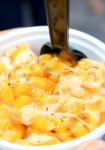Red is the colour militant Islamists shunned because it is identified with communists, or a kafir, meaning an infidel, but the Lal Masjid or the Red Mosque currently besieged by Pakistani troops to flush out militants remained synonymous with its 'red' brand of Islam ever since its inception over four decades ago.
The sprawling Masjid in central Islamabad perhaps is one of the rare mosques to have a name not connected with Islamic religion.
True to its name, it remained a centre of defiance ever since it was constructed in 1965, even though it was managed by the government.
Lal Masjid is the name given by Auqaf department that managed it, which many believe was due to its red-coloured walls and interiors.
Over the years, it became a centre of radical Islam playing a major role in generating the jihadis to fight the occupation of Afghanistan by erstwhile Soviet Union and after that transferred into a centre of extremist Sunni ideology.
Maulana Abhdullah, the father of the two clerics, Abdul Aziz and his younger brother Abdul Rashid Ghazi was chosen as the first cleric of the mosque by none other than Pakistan's first military ruler Ayub Khan.
The clerics remained in the payrole of the government ever since receiving state funds, salary and patronage.
Aziz was caught while fleeing from the besieged masjid in a burqa, while Ghazi along with hundreds of miltants are still holed up inside vowing to fight till death.
It was during military ruler Gen Ziaul Haq's time that Lal Masjid managed to acquire a lot of state land in Islamabad to build its sprawling madrassas for boys and girls.
Abdullah was gunned down outside the Masjid in 1998, by suspected rival Shia militants. After a brief lull, the mosque
became a centre of anti-US forces ever since Washington and NATO alliance took control of Afghanistan after 9/11.
The Masjid showed its street power for the first time in 2003 when a radical Sunni leader Aziz Tariq was killed.
It also passed a controversial edict in 2004 against Pakistani soldiers fighting in Waziristan tribal agency to flush out al-Qaeda and Taliban militants.
"It was the same year Lal Masjid's links with al-Qaeda were revealed with the arrest of Osama bin Laden's driver. The
government at that time also accused Abdul Rashid of masterminding attacks on government installations but he was
mysteriously cleared of those charges," the Dawn reports.
Ironically, the present Religious Affairs Minister Ijazul Haq, the son of Zia-ul Haq, reportedly admitted playing a role
in getting the brothers released. The mosque and its madrassas came under scanner in 2005, when its girl students resisted an operation in the wake of 7/7 London bombings after the UK called on Pakistan to crack down on radical Islamic schools.
The cleric borthers occupied a public library next to the mosque in January this year to protest the government's order
for demolition of unauthorised mosques and set up a moral brigade to close down music stores and alleged brothels.
They also passed a fatwa against former Tourism Minister, Nilofar Bhaktiar for hugging her trainer after a parajump and
then took the audacious step of abducting six Chinese citizens alleging that they ran brothels.






 © 2025
© 2025